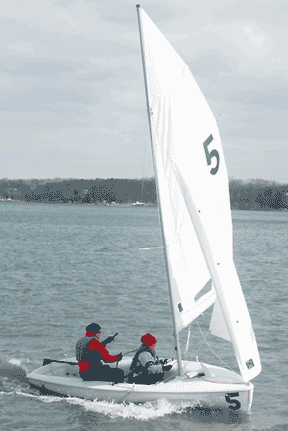 |
|||||||||||
|
|||||||||||
|
|||||||||||
Sailors DownHow March winds taught southern Maryland teens a lesson
by Margaret TearmanThe Ides of March dawned sunny and unseasonably warm; highs were forecast to reach 80 degrees. The pre-spring prelude to summer drew Marylanders out. In Solomon’s Harbor, a dozen students from two Southern Maryland high schools, Patuxent in Calvert and Leonardtown in St. Mary’s, all members of Southern Maryland Sailing Association, practiced their sailing skills under the supervision of coach Stovy Brown. For the student sailors — who’ve been on the water since February — warmth was a bonus. “We had been watching the weather,” said coach Brown. “We knew a cold front was forecast for sometime that afternoon.” But the black clouds that usually announce an approaching weather front were nowhere in sight. “We kept our eyes on the horizon, watching for the front,” Brown told Bay Weekly. “We did see a few dark clouds, but they quickly blew away and the sun kept shining.” The horizon never warned the sailors of the strong cold front bearing down. Then a stealth wind cut through the sun-drenched skies. On its impact, all six small sailboats, called day-sailers, were toppled. The teenage crews plunged into the 40-degree water. Onlookers said later the only clues to the oncoming front were “dust clouds” whipping across dirt roads and the sudden roar of the wind in the leafless trees. The older, more experienced kids, mostly seniors, had been on the water for about an hour when the storm hit around 4:30pm. The younger teams had been on the water for less than 15 minutes. A lifelong sailor, Brown — now retired from IBM — has coached youth sailing since his college days at Yale. In 1999, he was the founding high school coach at Southern Maryland Sailing Association. “I check multiple forecast sites, including The Weather Channel, several times each morning,” Brown said. Brown said he was aware that a small craft advisory had been posted, but he wasn’t anxious. “Sailors don’t usually worry about advisories,” he said. “They usually mean good sailing conditions.” He didn’t have a marine radio on board his boat, but he kept his eyes on the sky. When the first gust hit, it was “tremendous, out of nowhere,” Brown said. The sudden wind toppled the six small boats. One crew righted its boat. They’d learned to strike a collapsed main sail, and now they sailed safely to shore under the jib. The other five crews couldn’t right their boats. All 10 teens had to be rescued from the icy bath. Brown, assisted by two private boats in the water, was able to pull everyone out in “about 10 minutes.” Early stories reported “a lot of screaming.” But Brown said there was no panic. The kids all did exactly what they had been taught. “If there was any screaming, it was probably one of the kids directing a rescue boat,” said Brown. “They are taught be in charge of your own rescue and learn to direct rescue vessels to avoid propellers getting tangled up in sails.” Earlier in the day, basking in the warm sun, some of the young sailors had complained to Brown about having to wear the uncomfortable wet — and some the more confining dry — suits. He reminded them of the 120-Degree Rule: If combined air and water temp is below 120 degrees, wear a wet or dry suit. They all had on either a wet or dry suit — plus, of course, a PFD. “Thankfully, the kids were properly outfitted for cold water in wet suits and life vests,” said U.S. Coast Guardsman Lt. Isaac Saenz, out of Baltimore. “Otherwise, this incident could have ended in tragedy.” Both the Coast Guard and Brown were impressed by the quick action of the first responders, who arrived “within minutes” after the sailors were in – and out – of the drink. “So many agencies responded quickly, including the Calvert County Dive Team, the U.S. Coast Guard, Natural Resources Police — plus helicopters from the Maryland State Police and Patuxent Naval Air Station. A handful of good Samaritans on shore called 911,” Brown said. “We are all extremely grateful for the response.” A couple of the teens were treated at the scene for possible hypothermia, and all were released to parents. “Nobody went to the hospital,” Brown said. “They were all cold, but they were all okay.” Friday’s rain and snow kept the young Southern Maryland sailors off the water, but by Saturday five of the rescued teens were back onboard, competing in a regatta on the Magothy River in Severn — unfazed by the cold. Boater BewareEarly spring warmth has boaters itching to get on the water, and some fishermen are already out. But boater beware. Spring winds blow fierce and unpredictable. The water is still cold, and an unplanned swim can be deadly. “Survival time varies depend on clothing, height, weight, age and general health, “ Coastguardsman Saenz explained. “You hear stories of people surviving hours in icy water, while others may only last minutes.” Chesapeake Country is infamous for spring weather changing by the minute. Be aware of bad weather headed your way. Marine radios regularly broadcast NOAA advisories and warnings. Coast Guard stations and marine patrols use colored warning flags to visually alert boaters of changing and potentially hazardous weather conditions. Don’t let deceptive balmy air tempt you to leave behind proper attire. Flip fops and a T-shirt won’t protect a swimming boater from deadly hypothermia. Nor will a wet suit left dockside be of any help. Margaret Tearman joins Bay Weekly as Calvert County reporter.
|
|||||||||||
|
|||||||||||
|
|
|||||||||||
|
© COPYRIGHT 2007 by New Bay Enterprises, Inc. All rights reserved.
|
|||||||||||

